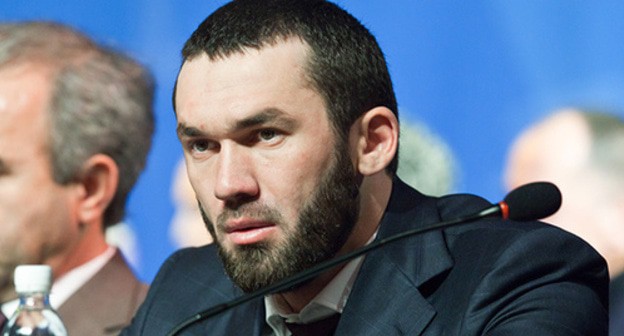Armenians
They call themselves Khai. A nation in the Southern Caucasus, the main population of Armenia. They live in more than 70 countries. Their population in Armenia is 3,08 million people (1992), in the Russian Federation --532 thousand people (data of the census of 1989), in Georgia - 437 thousand people, in the USA - 700 thousand people, in France - 270 thousand, in Iran - 200 thousand people, in Syria - 170 thousand people, in Nagorny Karabakh - 146 thousand people, in Turkey - 150 thousand people; there are big diasporas in Iraq, Egypt, Lebanon, Argentina, Brazil, Canada, Greece, Uruguay, Australia, Bulgaria, Great Britain, Kuwait, Romania, India. Their total population is 6,55 million people. They belong to Armenoid (Middle Asian) race of the big European race. They speak Armenian language that forms a separate group of the Indo-European branch. There are the western and the eastern dialects and sub-dialects. Russian language is common among the Armenians living on the territory of the former USSR. Their literacy is based on Armenian alphabet. Armenians-believers are mainly Christians- monophysites, a small number of Armenians not living in Armenia are Armenian Catholics, Catholics and Protestants.
According to the Hett, Mitanny and Assyrian sources the multilingual tribes inhabiting the Armenian plateau had multiple political states as early as the second half of the 2nd millenium B.C. One of them was the ?Urartu country? (in the Assyrian sources; the ancient Hebrew name is ?Ararat country?). In the 9th century B.C. it leaded the process of uniting the scattered tribal principalities of the Armenian plateau into a united state. This was mainly caused by a need to resist the invasions of Assyria. The tribes of the Armenian plateau spoke the Urartu-Hurrit, Hetto-Luvian and proto-Armenian Indo-European languages. They achieved the territorial, political, economical and cultural unification. The forming of the ancient Armenian nationality took place in Urartu state in the 9-6th centuries B.C. In the 6th century B.C. in the ancient Persian texts the ?Armina country? is mentioned (in ancient Greek - Armenia) that occupied the Armenian plateau; the Armenian nation was formed. The population called their country Hike (Aik) after the mythological ancestor, hence the way they call themselves. Armenian nationality formed first in a slave-owning, then in a feudal system in a constant struggle with different intruders (Persians, Romans, Parfians, Arabs, Turks-Seldzhuks etc.). In the year 301 Armenians took Christianity. The Armenian alphabet was made in 405-406 and it?s used until nowadays nearly without alterations. The making of the alphabet played an important role in the development of Armenian culture. This helped to keep and strengthen the ethnic self-consciousness and to support the close connections between the groups of Armenians scattered all around the world. As a result of mass resettlements and expulsions of Armenians during the never-stopping wars there appeared multiple Armenian colonies in many countries of the world. First they appeared in the Middle East; After the Arab conquest (7th century) and the invasions of the Seldzhuks (11th century) there started a mass emigration of Armenians and they moved to Europe, the cities of the Golden Horde, to the Crimea, Poland and Ukraine. In the 11-14th centuries the number of Armenians increased in Byzantium, Egypt, Syria, Lebanon, big colonies formed in Galicia, Moldavia, Hungary etc., in the beginning of the 17th century - in Iran. In the beginning of the 18th century many Armenians moved from Iran to India, China, Burma, the Philippines and Java. In Russia there were Armenian colonies in St. Petersburg, Moscow, Astrakhan as well as in the North Caucasus and in the mouth of the river Don. There was active social and political life in the colonies and they played an important role in the development of Armenian culture.
In 1805-1828 the Eastern Armenia joined Russia. Before the WWI a big number of Armenians (about 4 million people) lived compact on the historical territory of Armenia: among them 1,5 million people lived in the Russian Empire, the rest - in Turkey. In 1915-16 the Osman authorities committed genocide, more than 1,5 million people were killed and over 600 thousand people were driven away (mainly to the fruitless districts of Mesopotamia). Because of that and the forced emigration there was nearly no native population left in the Western Armenia, Armenians got scattered around many countries of the world. Over 300 people found safety in Russia. Many Armenians returned to their motherland when an Armenian Soviet Socialist Republic was formed in November 1920 (since 1991 - independent Republic of Armenia). At modern times the migration of Armenians to Russia increased after the events in Azerbaijan that were tragic for Armenians and after an earthquake in Spitak in 1988. During this period the number of Armenians in Russia increased many times : according to the census of 1989 there were 532 thousand Armenians living in Russia, in 1993 this number reached 1,5 million.
In the 19th - beginning of the 20th century the main part of Armenians on their native ethnic territory preserved a traditional way of economy. It was agriculture and cattle-breeding in the mountains and in the valleys. They grew wheat, barley, millet, rye, flax, hemp, rice. In the valleys they were busy with vine-growing and horticulture (apples, pears, pomegranats, plums, apricots, peaches, quince, figs, mulberry, walnuts, almonds etc.) In cattle-breeding (big and small cattle, buffaloes, pigs, horses, donkeys and mules) draught cattle-breeding was most important. Depending on historical and environmental conditions the cattle-breeding was either distant-pasture or not. Most popular trades were carpet-making, embroidery, lace-making, stone-carving and jewelry (chasing, filigree, enamel).
Each ethnographical district of Armenia has features both common for Armenia in general and unique for the special features of material culture.
The main kind of a traditional dwelling - glkhatun (tun) is a square building on the ground of partly under the ground with no windows, rough stone walls and a pyramid-shaped roof (made of wood and earth). It often rests on an inner carcass made of piles with a smoke outlet in the center. In some districts the living and the household rooms were under the same roof, in warmer districts they were separate. Glkhatun was lighted through the smoke outlet and had clay stoves in the floor (tonirs) and fireplaces in the walls (bukhari). Sometimes they constructed pise-walled houses with flat roofs. In the villages the houses were placed next to each other, crowded, sometimes they were connected by secret passages for defense reasons. In the mountains the roof of one house could be the yard of the other. Seasonal settlings appeared in the districts of distant-pasture cattle-breeding. During the last third of the 19th century the city houses appeared in the villages - with 1,5 or two floors, big windows, tiled 2-slope and 4-slope roofs and an opened veranda. By the middle of the 20th century most of the houses in Armenia were two-floor rectangular or square structures built of well-polished tufa of concrete blocks or rough stone with many rooms and a four-slope tin or slate roofs and opened or glassed verandas, stove or water heating and other modern conveniences; the villages became more orderly, with streets, gardens and vegetable yards.
The main elements of the male and female costume were a low-neck shirt and wide trousers. Women wore trousers fixed at the ankles with a blister seam, men wrapped them with a wide winding. Over the shirt they wore arkhaluk (a kind of a long coat) (in Western Armenia men wore shorter waistcoats and jackets). On top of that they wore different kinds of overcoats of chukha (cherkeska) type and girded themselves either with a belt or (mainly women) with a long scarf. Women wore embroidered aprons. In the Eastern Armenia men wore fur hats, in the Western Armenia - felt and fabric hats. Women?s head gear were covers complimented by a band with different decorations. The footwear was made of raw-hide, shoes on a small heel with a turned-in tip or soft leather boots.
Of all the components of traditional culture the most well-preserved in the Armenian cuisine. It is based on cereals. They use wheat (in the past - barley) flour and in the tonirs they bake thin bread - lavash, make cookies and other flour dishes, including noodles - arshta. They use cereals for porridge, pilav and soup. Dairy products are popular: cheese, butter, sour milk - matsun and buttermilk - tan. Tan is used as a cold drink and as a base for soups. Poor people seldom ate meat: in the rite dishes they used boiled meat, on holidays they ate fried meat. There?s a big variety of mixed vegetable, cereal and meat dishes: arisa - porridge with meat boiled till it falls apart, kufta - soup with meat-and-cereal rissoles, tolma - meat and cereals wrapped in vegetable leaves, etc. They make many kinds of grape and fruit preserves. They widely use fresh and dried aromatic herbs.
The system of relationship is of English type. Traditional families are extended, patriarchal and have a distinct regulation of the rights and obligations of its members according to their sex and age. Traditions of mutual aid between relatives and neighbors started to destroy in the 19th century.
Armenian folklore includes different genres: fairy-tales, songs, epic stories (cycle ?The Sasun Mighty Knights?). Among the ancient songs the best are labor songs and nostalgic songs of a traveler - pandukht. The epic stories and the songs are performed by folk singers - gusans.




![Tumso Abdurakhmanov. Screenshot from video posted by Abu-Saddam Shishani [LIVE] http://www.youtube.com/watch?v=mIR3s7AB0Uw Tumso Abdurakhmanov. Screenshot from video posted by Abu-Saddam Shishani [LIVE] http://www.youtube.com/watch?v=mIR3s7AB0Uw](/system/uploads/article_image/image/0001/18460/main_image_Tumso.jpg)